The digitization of family history has made finding new information about your ancestors and collaborating with other relatives easier than ever. But sometimes mistakes creep into the records.
While researching a branch of my family recently, I discovered an error on an ancestor’s FamilySearch page – but was able to correct it with the help of a newspaper article I discovered using GenealogyBank’s Historical Newspaper Archives.
Philip Mosher (1772-1837), (my 2nd cousin, 6x removed), was born in New Bedford, Bristol, Massachusetts, on 30 July 1772. His FamilySearch entry noted that he died in 1837 – but there’s something odd about his death details. According to that record, Philip supposedly died in Spring Hill, Hempstead, Arkansas, and was buried at sea, which seemed strange because Arkansas is landlocked.
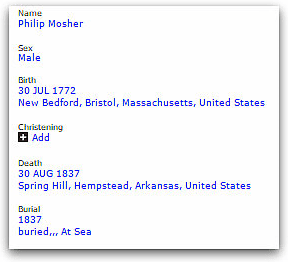
It seemed unlikely that Philip would have been buried at sea after dying nowhere near the ocean, so I decided to search GenealogyBank’s Historical Newspaper Archives to see what details I could find about Philip’s death.
My first search included Philip’s full name, his hometown of New Bedford, and his death year.
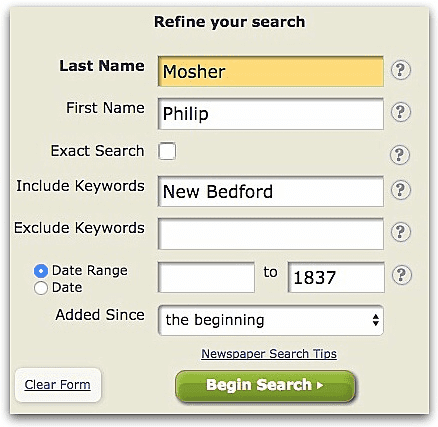
The first result was a funeral notice from the New-Bedford Mercury:
“The funeral of Capt Philip Mosher will be attended this afternoon, at 2 o’clock, from 91 North Water st.”
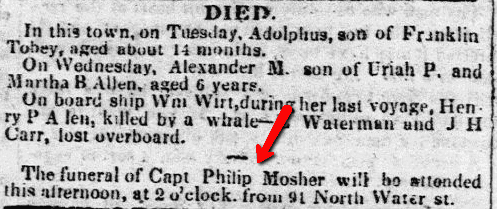
This funeral notice tells me that there was a memorial service for Philip in New Bedford, but doesn’t tell me where he died – so I kept looking.
Next, I searched for Philip using a different strategy. I know “Philip” is commonly spelled “Phillip” with two L’s, so this time I searched for “Phillip Mosher” with the keyword “New Bedford” and his death year.
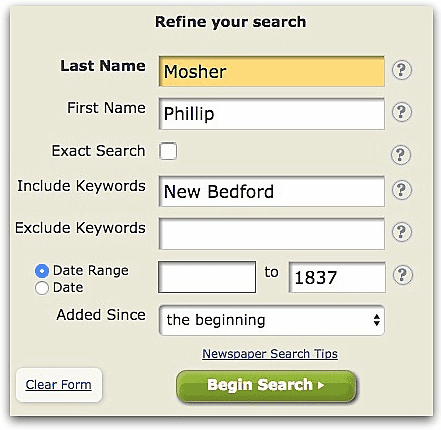
The second result, an article from Trumpet and Universalist Magazine, gave me the detail about Philip’s death that I was searching for:
“Loss of the Cutter M’Lane. – The seamen belonging to the U.S. Revenue Cutter M’Lane, Lt. Com. Sturgis [captain], have just arrived from Naushon with intelligence that as the Cutter was beating into Hadley Harbor yesterday afternoon, she was suddenly struck by a squall, and in a few minutes sunk to the bottom.
“The vessel was carried under so suddenly that the pilot, Mr. Phillip Mosher of this town, was drowned. The collector of this port was on board at the time, who, together with the officers and crew, succeeded in reaching the island in safety. By this disaster Lt. Sturgis has lost much valuable property that he had on board. The vessel, if never recovered, will be no great loss to the government – for she was never suitable to cruise on this coast. –New Bedford Gaz.”
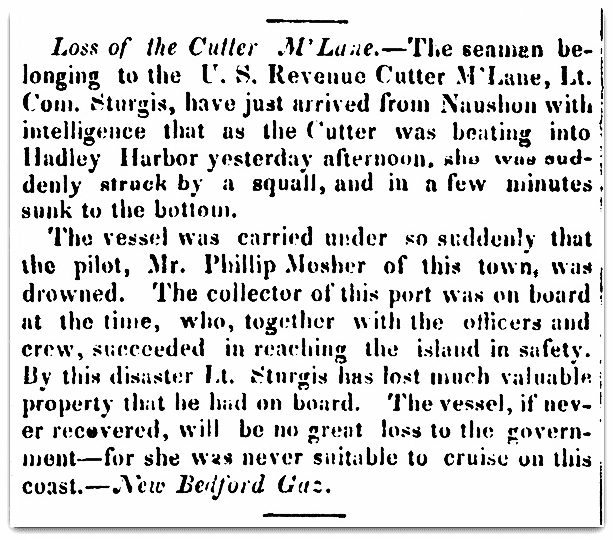
The article mentions that the pilot Mosher that died aboard the cutter McLane was from New Bedford, suggesting that this is indeed the Philip Mosher we were searching for. The ship sank on 30 August 1837.
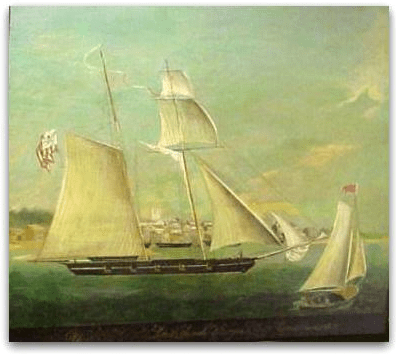
Named for Louis McLane, the tenth Secretary of the Treasury of the United States, USRC McLane was noted for her beautiful deck finish and cabinet work. An early historian of the Service, Revenue Captain Horatio D. Smith, USRCS, wrote of her:
“The Revenue Cutter McLane when finished in 1832 was ordered to Washington, and while at the Navy Yard was visited by many people, especially members of Congress, and was admired by all for her beauty, symmetry and elegance of finish. Her armament was four brass 9-pounders on elegant carriages, with small arms to correspond. Other vessels were built of larger dimensions, but the McLane excelled them all in beauty and sailing qualities. She was the crack vessel of her time.”
Source: Wikipedia
Now that I have this record of Philip’s death “at sea” and his funeral notice, I can confidently list Philip’s place of death as Hadley Harbor, Gosnold, Dukes County, Massachusetts, instead of Spring Hill, Arkansas.
Genealogy Tip: If you’re having a difficult time locating an ancestor, try searching for their name in GenealogyBank’s Historical Newspaper Archives using an alternate spelling – swapping out a letter or two might produce just the information you were searching for.
